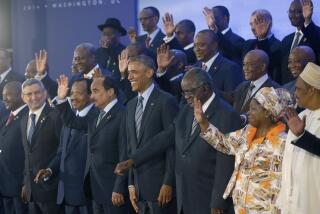U.S. Cellular Phone Firm Calls on Africa
- Share via
NEW CANAAN, Conn. — Only about one in every 100 people in Africa has a telephone, but that hasn’t stopped one Connecticut company from finding big success in selling cellular systems there.
While many U.S. phone companies have focused in recent years on Asia and South America as growing cellular areas, Telecel International Ltd. quietly tapped the cellular market in Africa over the last 10 years.
It now operates systems in five African nations and plans to expand to four more within the next year.
“The existing [land-line] phone system was very bad, so they needed something else,” said Telecel President Miko Rwayitare, a native of Zaire who helped found the company in 1985. “The demand can be supported by cellular.”
Telecel first introduced cellular service in Africa in 1986, when it gave the government of Zaire a free pilot system for one year.
“By then, they were so used to communicating with it, they didn’t want to dispense with it,” Telecel Chairman Joseph F. Gatt said.
Eventually, the company expanded its wireless systems from Zaire into Burundi, Madagascar, Guinea and the Central African Republic.
Telecel’s sales have skyrocketed over the last five years, jumping from $5.1 million in 1990 to $54.1 million in 1995. And the company projects sales will grow by at least 25% each year for the next three years.
But before the sales’ boom, the company first had to break into this closed market.
The African nations, which were used to operating their own systems, needed to be persuaded to grant Telecel an independent private communications license. Telecel also has had to wage a long-term marketing campaign to convince African people that cellular phones are not a futuristic technological fantasy.
“It was very hard to do because first of all, they thought it was a walkie-talkie, [that] it was not an actual telephone,” said Gatt, the former chief executive of Aire Zaire, the state-run airline.
“They didn’t believe it would work as well as it does, and they could not believe that they actually could communicate not only with each other but with other cities and with anyone else in the world,” he said.
When Telecel began offering cellular service in 1986, it cost an African resident about $5,400 for a cellular phone set, plus a $100-per-month subscription fee and 36 cents per minute for usage.
Today, those costs are down to about $240 for the phone set; $50 per month for the subscription fee; and 30 cents per minute.
Still, most of Telecel’s subscribers are well-off Africans, including embassy workers, foreign businessmen, local business owners and government workers.
Telecel’s profits have grown from $50,000 in 1990 to $9.5 million in 1995. Its work force has gone from just four employees in 1985 to about 400 today. Thirty-five employees work at its New Canaan, Conn., headquarters; most of the others are based in Africa.
The company’s number of cellular subscribers is small--about 15,000, compared with the 34 million cellular subscribers in the United States. But the business is profitable for Telecel, partly because cellular usage tends to be intense among subscribers in Africa, where traditional land-line systems are often unreliable.
In Zaire, for example, usage averages about 680 minutes per month for a subscriber, while in the United States usage averages about 100 minutes per month.
Although larger U.S. telecommunications companies have been rapidly expanding their cellular services into overseas markets--many in developing countries--Africa has not been the top choice for expansion.
Instead, many of the big players have focused on Asia and the Americas, where economies are growing at a much faster rate.
“The amount of interest in doing wireless in East Asia swamps whatever anybody is doing in Africa,” said David Roddy, a telecommunications economist at Deloitte & Touche Consulting Group in Atlanta.
“Africa is probably a nice niche market, but clearly wireless systems--most of them over the next 10 years--will be built in East Asia,” he said.
“Most people in the telephone business require economic growth in order to sell telephone service . . . and in other parts of the world--Africa and even Eastern Europe--the economic growth is just not there at the moment,” Roddy said.
Most of Telecel’s competitors in Africa are not private U.S. companies, but government entities from France and South Africa, and an independent company from Sweden.
GTE Corp. said it has focused its international cellular efforts in Latin America, where it has already had a strong presence for years, and in Asia, where in many places just two or three out of every 100 people have telephones.
“It’s really a case where you can’t be everywhere,” said Harvey Greisman, vice president of international public affairs for Stamford, Conn.-based GTE.
Motorola, however, currently has systems in 19 African countries, where a service provider is using Motorola’s infrastructure--such as radio and switching equipment--to provide cellular services.
Eugene O’Rourke, Motorola’s senior director and general manager for Africa and Middle East operations, said the company sees great potential for cellular growth in Africa because of low “teledensity” rates of anywhere from 0.5 to 9.5 phone lines per 100 people and the high costs of maintaining traditional land-line phone systems.
“There are lots of natural disasters . . . and it’s very difficult to lay copper wire and have it work reliably, so in many countries they have found that it’s much cheaper to put in cellular and cellular spinoffs than it is to try and run copper wire,” O’Rourke said.
Telecel first introduced cellular phones in large cities, then gradually moved out to smaller cities.
With its success in Africa, Telecel is now looking to the Ukraine, where it expects to have a cellular system up and running within the next year.
More to Read
Sign up for Essential California
The most important California stories and recommendations in your inbox every morning.
You may occasionally receive promotional content from the Los Angeles Times.











